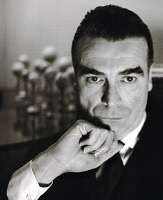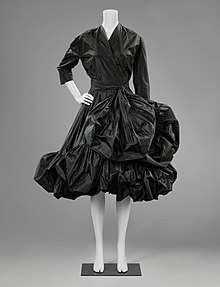Cristóbal Balenciaga
| Cristóbal Balenciaga | |
|---|---|
 Cristóbal Balenciaga in 1950 | |
| Born |
Cristóbal Balenciaga Eizaguirre January 21, 1895 Getaria, Spain |
| Died |
March 23, 1972 (aged 77) Xàbia, Spain |
| Resting place | Getaria cemetery[1] |
| Other names | Basque: Cristobal Balentziaga Eizagirre |
| Label(s) | Balenciaga |
Cristóbal Balenciaga Eizaguirre (pronounced [kɾisˈtoβal βalenˈθjaɣa ejθaˈɣire]; January 21, 1895 – March 23, 1972) was a Spanish Basque fashion designer and the founder of the Balenciaga fashion house. He had a reputation as a couturier of uncompromising standards and was referred to as "the master of us all" by Christian Dior and as "the only couturier in the truest sense of the word" by Coco Chanel, who continued, "The others are simply fashion designers". He continues to be revered as the supreme deity of the European salons. On the day of his death, in 1972, Women's Wear Daily ran the headline "The king is dead" (no one in the fashion world had any doubt as to whom it referred).
Since 2011 the purpose built Museo Balenciaga has exhibited examples of his work in his birth town Getaria. Many of the 1200 pieces in the collection were supplied by his pupil Hubert de Givenchy and clients such as Grace Kelly.
Life and career

Balenciaga was born in Getaria, a fishing town in the Basque province of Gipuzkoa, (Spain) on January 21, 1895.[3] His mother was a seamstress, and as a child Balenciaga often spent time with her as she worked.[3] At the age of twelve, he began work as the apprentice of a tailor.[4] When he was a teenager, the Marchioness de Casa Torres, the foremost noblewoman in his town, became his customer and patron.[3] She sent him to Madrid, where he was formally trained in tailoring.[3] (Balenciaga is notable as one of the few couturiers in fashion history who could use his own hands to design, cut, and sew the models which symbolized the height of his artistry).
Balenciaga was gay,[5] although he kept his sexuality private throughout his life.[6] The love of his life and long time partner was Franco-Russian milliner Vladzio Jaworowski d'Attainville, who had helped fund setting him up. When d'Attainville died in 1948, Balenciaga was so broken he considered closing the business.[7]
Balenciaga was successful during his early career as a designer in Spain. He opened a boutique in San Sebastián in 1919,[8] which expanded to include branches in Madrid and Barcelona.[3] The Spanish royal family and the aristocracy wore his designs, but when the Spanish Civil War forced him to close his stores, Balenciaga moved to Paris.[3][4] He opened his Paris couture house on Avenue George V in August 1937.[3]
However, it was not until the post-war years that the full scale of the inventiveness of this highly original designer became evident. In 1951, he totally transformed the silhouette, broadening the shoulders and removing the waist. In 1955, he designed the tunic dress, which later developed into the chemise dress of 1957. In 1959, his work culminated in the Empire line, with high-waisted dresses and coats cut like kimonos.[9]
In 1960 he made the wedding dress for Fabiola de Mora y Aragón when she married King Baudouin I of Belgium. The Queen later donated her wedding dress to the Cristóbal Balenciaga Foundation.[10]
He taught fashion design classes, inspiring other designers including Oscar de la Renta, André Courrèges, Emanuel Ungaro, Mila Schön and Hubert de Givenchy.[3]
His often spare, sculptural creations were considered masterworks of haute couture in the 1950s and 1960s.
Balenciaga closed his house in 1968 at the age of 74 after working in Paris for 30 years. He decided to retire and closed his fashion houses in Paris, Barcelona and Madrid, one after the other.[4] Balenciaga died on March 23, 1972 in Xàbia, Spain.
Today the Balenciaga fashion house continues under the direction of Demna Gvasalia and under the ownership of the Kering Group.[11]
Work
During the 1950s designers like Christian Dior, Pierre Balmain, and Coco Chanel, emerged, creating pieces very representative to their fashion houses and to their own styles. An important protagonist for this period was Cristobal Balenciaga. This Spanish fashion designer was known as "The King of Fashion" and was one of the great masterminds of the period. Balenciaga was born and raised in Spain, where he worked for the Spanish royalty, but because of the Spanish Civil War he moved to Paris where he became this "King of Fashion".[12]
The most eye-catching designer of this period was Balenciaga because of his structural designs, which had never before been seen in the fashion world. He was a master of tailoring, and he was able to translate his illustrations from paper to real life. His advanced tailoring skills gave him an advantage over designers all over the world, making him a major target for customers.[13] "He reshaped women's silhouette in the 1950s, so that clothes we think as typical of that decade are mostly dilutions of his work" (Irvine, 2013).[14] Compared to some work like the New Look from Christian Dior, which featured full skirts and a tiny waist,[15] Balenciaga changed these to look like the Yoki coat, which was a one-seam coat, or to voluminous looks. However, this look made customers travel from all over the world for his outfits.
Expositions
On 24 March 2011, San Francisco's M. H. de Young Museum celebrated the opening of "Balenciaga and Spain", a 120-piece fashion retrospective of his career. "You can't even measure it", said Rodarte designer Laura Mulleavy, of Balenciaga's influence. The $2,500-a-ticket fund-raiser for the museum drew 350 guests, including Marissa Mayer, Jamie Tisch, Gwyneth Paltrow, Orlando Bloom, Balthazar Getty, Maggie Rizer, Connie Nielsen, Maria Bello and Mia Wasikowska.[16]
On 7 June 2011, the Balenciaga Museum was inaugurated in his hometown of Getaria by Queen Sofía of Spain and with the presence of Hubert de Givenchy, honorific president of the Balenciaga Foundation.[17] The museum has a collection of more than 1,200 pieces designed by Balenciaga, some of them donations by disciples, like Givenchy, or clients, like Queen Fabiola of Belgium and the heirs of Grace Kelly.[18]
His most famous clients were Mona von Bismarck, Grace Kelly, Ava Gardner, Audrey Hepburn and Jackie Kennedy.
References
- ↑ Hispano americano, Volume 60, Issues 1539-1552, Tiempo, 1971, pg 72
- ↑ Weijkamp, Birthe (26 February 2015). "Een 'echt' Parijs model?" (in Dutch). ModeMuze. Retrieved 27 July 2015.
- 1 2 3 4 5 6 7 8 Charleston, Beth Duncuff (October 2004). "Cristobal Balenciaga (1895-1972)". Timeline of Art History. Metropolitan Museum of Art. Retrieved 2007-06-06.
- 1 2 3 "Cristóbal Balenciaga". Fashion, Jewellery & Accessories. Victoria and Albert Museum. Archived from the original on 2007-11-23. Retrieved 2007-06-06.
- ↑ Haggerty, George (2013-11-05). Encyclopedia of Gay Histories and Cultures. Routledge. ISBN 9781135585068.
- ↑ Kaiser, Susan B. (2013-08-01). Fashion and Cultural Studies. A&C Black. ISBN 9780857854315.
- ↑ Blume, Mary The Master of Us All: Balenciaga, His Workrooms, His World, Farrar, Straus and Giroux, 2013
- ↑ Breward, Christopher (2003), Fashion, Oxford History of Art, New York: Oxford University Press, p. 81, ISBN 978-0-19-284030-1
- ↑ "Cristóbal Balenciaga | Spanish designer". Encyclopedia Britannica. Retrieved 2018-07-25.
- ↑ NOVIAS – Wedding dress in ivory satin and white mink – 1960 – The Queen donated her wedding dress to the Cristóbal Balenciaga Foundation.
- ↑ Cole, Shaun (2002), "Fashion", glbtq.com, archived from the original on 2015-02-26
- ↑ Schillinger, L (2013). Opening up the couturier Cristobal Balenciaga. Paris: International Herald Tribune.
- ↑ Miller, L.E. (2007). Cristobal Balenciaga (1895-1972): The couturiers’ couturier (2nd rev.ed.). New York; London:: V&A Publications.
- ↑ "Couture's divine mystery". Daily Telegraph. London. 2013.
- ↑ Müller, F., Bongrand, C., & Pushkina. (2011). Inspiration dior. New York: Abrams Publications.
- ↑ WWD.COM (25 March 2011). "A Spanish Night for Balenciaga in San Francisco". Women's Wear Daily. Retrieved 27 March 2011.
- ↑ "375 invitados arropan a la Reina Sofía en la inauguración del Museo Balenciaga" (in Spanish). El Mundo. 7 June 2011. Retrieved 5 August 2013.
- ↑ "Abre el museo Balenciaga, el primero dedicado a un modisto" (in Spanish). Reuters. 7 June 2011. Retrieved 5 August 2013.
External links
| Wikimedia Commons has media related to Cristobal Balenciaga. |
- Cristóbal Balenciaga at Chicago History Museum Digital Collections
- Official website - Balenciaga house
- Balenciaga Museum
- Balenciaga
- "Cristóbal Balenciaga 1950s Tailored Suits". Victoria and Albert Museum. Retrieved 2007-11-13.
- Cristóbal Balenciaga at the Fashion Model Directory
- Balenciaga library collection at the BelMal Malletier Fashion Library (Belgium)
- Charleston, Beth Duncuff. “Cristobal Balenciaga (1895–1972).” In Heilbrunn Timeline of Art History. New York: The Metropolitan Museum of Art, 2000–. (October 2004)
- Irvine, Susan (3 September 2013). "The mysterious Cristóbal Balenciaga". The Telegraph. Archived from the original on 22 January 2015. Retrieved 3 August 2015.
